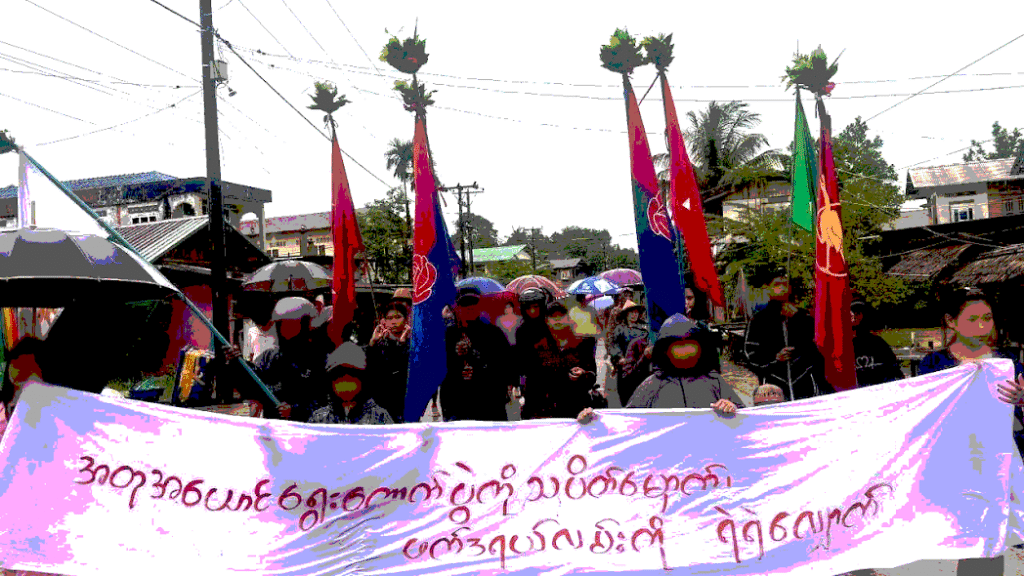Myanmar Spring Chronicle – October 20 Perspective
(MoeMaKa, October 21, 2025)
Who bears the burden of war?
When wars erupt, the essential requirements include manpower to fight, weapons and ammunition, supplies and rations, and the motivation to take part — whether through conviction, political support, or financial incentives.
Looking at conflicts around the world — from civil wars to cross-border invasions or territorial disputes — many have arisen because ethnic or regional forces, historically tied to a territory, find themselves excluded from political or administrative authority within the borders of a state to which they do not feel they belong.
In this article, however, the focus is Myanmar’s internal conflict. Myanmar’s civil war has lasted for over 70 years — making it one of the world’s longest-running civil wars. Since independence, the country has been trapped in flames of internal warfare. The earliest years after independence saw some of the most intense fighting and destruction, and although the scale varied over the following six or seven decades, conflict never fully disappeared.
In the 1950s through the 1970s, internal wars broke out in regions such as the Bago Yoma. In the 1990s, fighting erupted again in the delta region. Along most border areas, armed conflict has waxed and waned for decades but never truly ceased.
After the 2021 military coup, Myanmar’s civil war reignited with the widest geographical spread and the greatest intensity seen in seven decades.
In the early years after independence, the Communist Party of Burma (CPB), seeking to establish a socialist dictatorship, and various ethnic armed groups fighting for federal self-determination, rose against the weak AFPFL government and the Burma Army.
Lessons from the first major civil war (1949–1952), which lasted nearly four years, might have offered opportunities for reform and reflection in later decades. After the disputed 2010 election, the so-called “elected government” of President Thein Sein initiated ceasefire talks and political dialogue, but within eight years, Myanmar entered what could be called its second nationwide civil war — the modern conflict that has expanded since 2021.
In wartime, ordinary people exhaust their savings, while those in power extract resources to sustain the war effort. Armed groups — both the junta’s forces and anti-junta militias — collect taxes far beyond normal levels from the areas and roads under their control.
In the junta-besieged city of Sittwe, Rakhine State, reports describe residents dismantling their own house doors and fences to use as firewood, a stark illustration of how dire life has become under military blockade.
Across the country — from the south to the central plains, and from the north to the east — social media users frequently report on multiple armed groups operating road checkpoints and collecting “tolls” or “taxes” from vehicles and travelers.
In resource-rich regions, armed groups impose heavy levies on resource extraction — a pattern long familiar during Myanmar’s civil wars. But the tolls on goods transported along trade routes are now so exorbitant that they would have seemed unbelievable in ordinary times.
For example, a recent report on the Lashio–Hsipaw–Kyaukme–Mandalay road stated that there are around 30 checkpoints between Mandalay and Lashio, and that total tolls for a single small car amount to about 400,000 kyats. Multiple armed groups operate those gates, including both the junta’s forces and the MNDAA, which maintains a ceasefire with the military.
Similar conditions prevail elsewhere: on roads linking Sagaing Region to Kachin State or Mandalay, there are dozens of checkpoints, and the tolls for fuel trucks reportedly reach into the hundreds of thousands of kyats.
In Karen State, the main trade routes connecting the Thai border with Hpa-an, Thaton, and Yangon reportedly have 40 to 50 checkpoints between Hpa-an and Myawaddy. Even small vehicles must pay tolls in the hundreds of thousands of kyats.
Such tolls constitute a major source of revenue — both for the armed organizations as institutions and for the individuals who staff those checkpoints.
Because goods entering from border areas must pass through so many checkpoints before reaching central Myanmar, consumers nationwide are forced to pay inflated prices for essentials — food, medicine, fuel, and all basic commodities.
These tolls, along with taxes collected from travelers, are a key wartime income stream. Another major source of war funding is natural resource extraction.
The junta relies on revenue from natural gas, oil pipelines, gold, gems, and minerals to fund its military operations — purchasing ammunition, fuel, and supplies. Meanwhile, resistance forces sustain themselves through direct or indirect taxation of jade, gold, rubies, crude oil, metals, rare earths, and timber extraction.
Although excessive resource extraction brings both short-term and long-term consequences — environmental degradation, destroyed farmland, polluted water, and toxic waste — neither side seems able or willing to prioritize these concerns amid the ongoing war.
Communities in mining regions suffer poisoned soil and rivers, while farmlands are damaged by gold dredging and tailings. Yet, for both the junta and resistance groups, winning the war has taken precedence over all else.
Ultimately, the root of all these interconnected problems — economic collapse, environmental destruction, and the exploitation of civilians — lies in the military coup and the wars it reignited.
Finding a solution depends entirely on the choices made by the political organizations and armed groups now engaged in this prolonged conflict.

